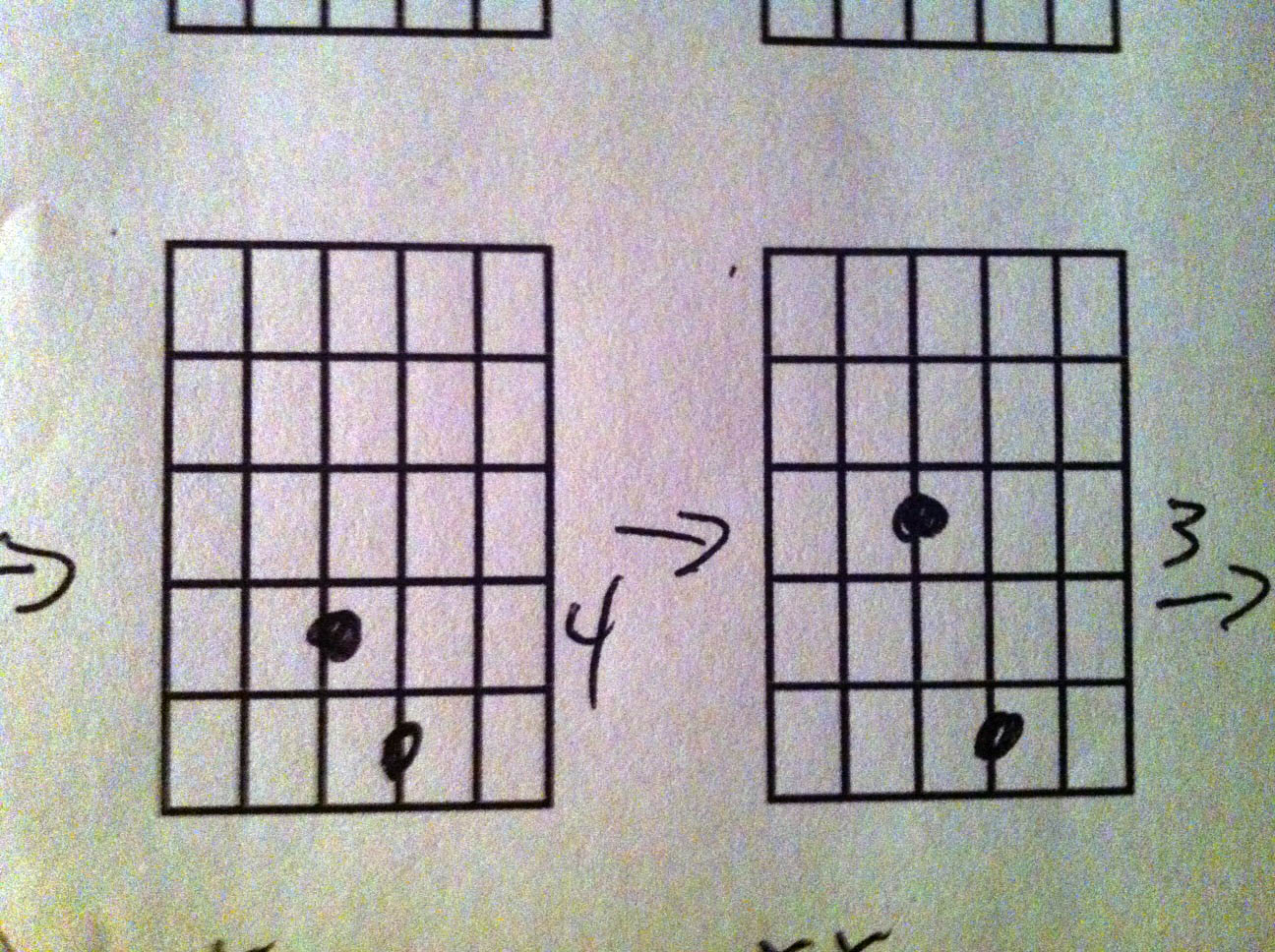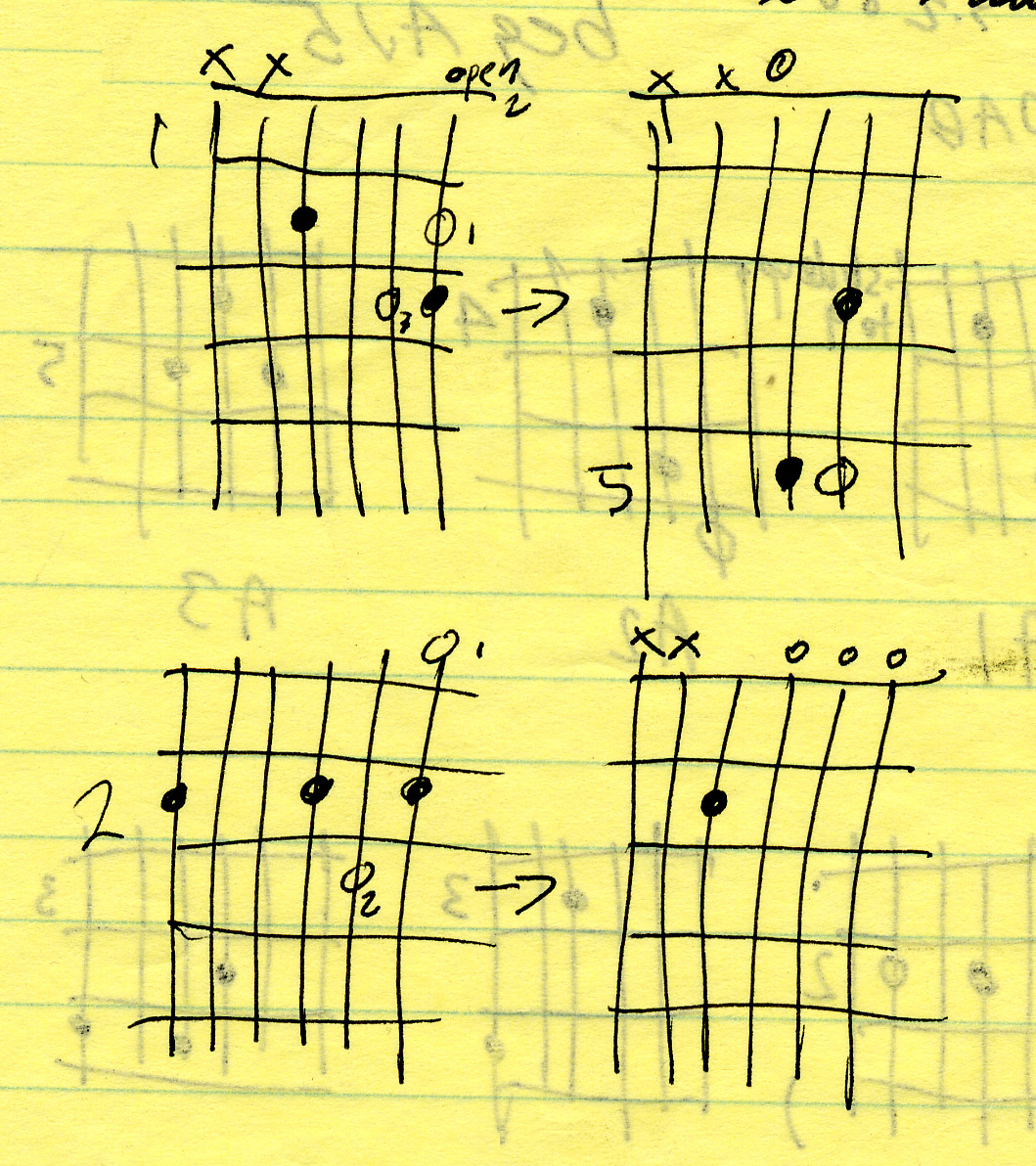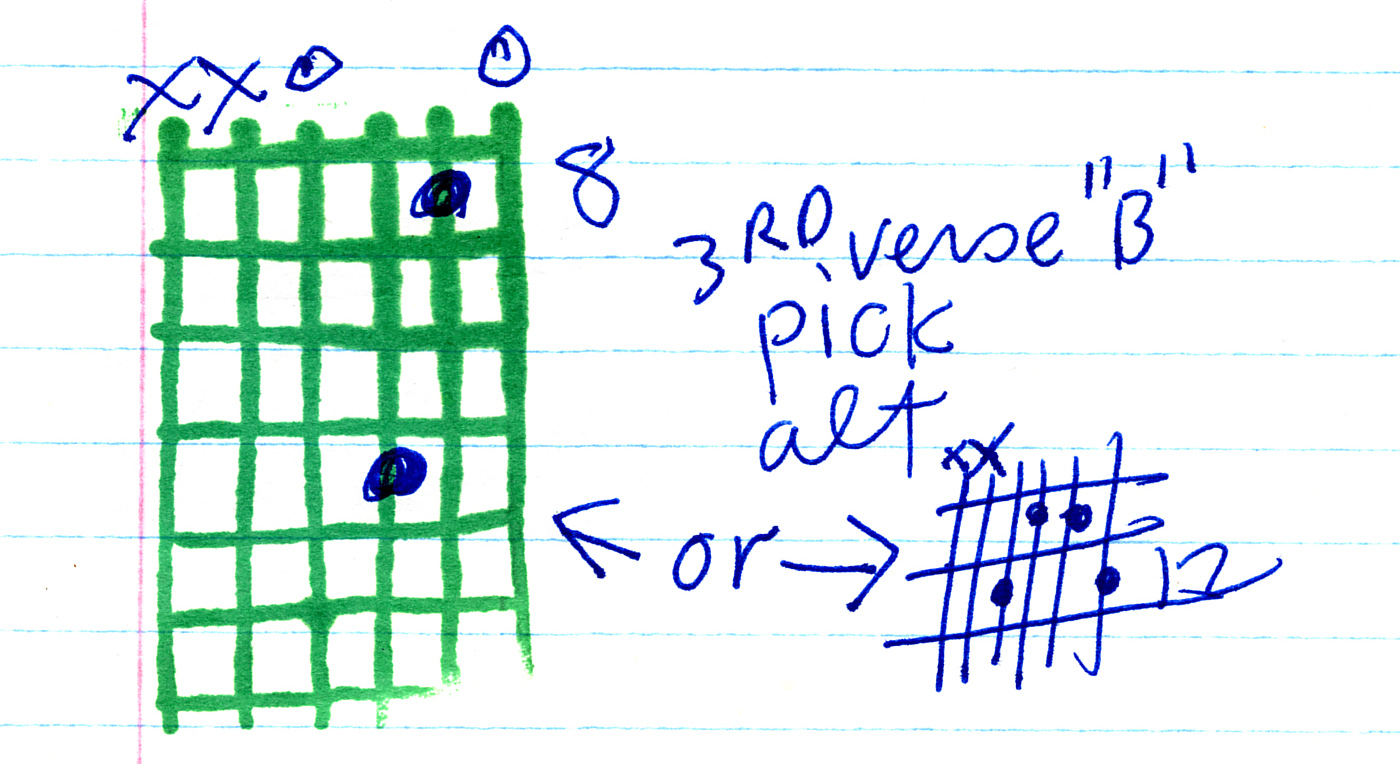
 |
Alt tunings - how to write?
Hey
I'm an uneducated simpleton and require some explanation. If you have a guitar tuned regularly (EADGBE) and start to write a song based around traditional chord fingerings, then you can obviously note this down as something such as Gmaj-Amaj-Eminor etc. But if I tune my guitar to some far out tuning, how would I go about noting down for future ref what it is I'm playing? Does this make sense or am I just not thinking about it?! Many thanklings. |
- Get a notebook. Draw charts or use some other inventive notation
-Record the songs so you don't forget them -If you feel particularly energetic, record yourself playing it with a camcorder. Make sure to focus on the left hand. or 3.) Master standard music notation and write everything out. This is the most time consuming option, though it may have a number of peripheral benifits. |
If you tab a song it doesn't matter what tuning it is.
There is a big difference between tabbing and noting just chords, like Gmaj-Amaj-Eminor. With alternate tuning it's imposible to name those "chords". For instance, in SY music you can't even tell whether it minor or major. So forget about Gmaj-Amaj-Eminor, that's for beginners :) |
Thanks for the replys. So do you reckon SY just invent new chord shapes they like, use these and give them names - thus creating a new library of chords to utilise?
|
Quote:
Sorta, there is a definite "key" they work songs in... its not like a completely unique language. I agree about using guitar tablature, thats what i do for my stuff. |
Quote:
I'm a bit of a music theory amateur - what do you mean by a key they work in? Do you mean the same way a musician using regular chord shapes and tunings would stick to a certain group of shapes that complement one another? Are there any decent websites or YouTube videos that trace the roots/outline the theory of alt tunings? |
A chord is the more or less simultaneous sounding of three or more notes.
For instance, the C major chord triad is a C, E, and a G note (the root (in this case, C), the third (E) and the fifth (G) on the diatonic scale starting with C (I-III-V)). And then you would just have to be acquainted with the chromatic scale and based on how the guitar is tuned at the nut find the notes necessary to make the chord or at least a triad (bearing in mind that any open strings played count as the note of the open string at the nut). Check out a circle of fifths for a further understanding of what scott v is getting at with the keys. Whie it is certainly not altogether necessary to know the specifics of theory, such an understanding can help make a good song that much more exciting. In general this seems especially true when one is puzzling over what the third progression of a tune or middle eighth part is going to be (since it is usually intuitively simple to write a couple of progressions/parts, and a lot of times it is the dominant chord to the tonic chord, but coming up with that third progression and/or riff, or any more than that, can be perplexing). Hope this helps to point you in a direction to search the internet. Most alternate tunings are comprised the way they are to make the fingering of the chords easier anyway. |
Tab them. Write down the chord figures / riffs. I think its useless to give these 'alternate chords' names..but there's always a key... because theyre modified chords but they still are made of tones. Ie: 'the sprawl' has got 'C' as its 'root' (bass/main) note but if you play C in standard tuning it pretty much loses the effect and texture that the modified notes add.
Anyway I think modified chords/alt tunings add a lot to songs.. First they sound fresh and new to the 'used' ear. And second they -sound- different...a chord shape of three F# tuned the same (not octaves) its a sound you can't get no matter how many fxs you put over a single F# note...... It also helps a lot in songwriting..when i play chords in standard theres a point when i feel all the chord changes sound predictable...in alternate tunings..you may play the same root notes of any classic song but the modified notes make it sound new and exciting..like the songs you write when you first start playing guitar. |
Guitar in standard tuning goes on virtually forever by itself, but yes, additional types of voicings and colors are possible with alternate and open tunings. And cool music is so often about some wild tones.
And yeah, you can go the Eno route (of course we are discussing guitars and not keyboards, but just what sprang to mind) and just eliminate what sounds off and tab what sounds good. |
just because a guitar is tuned differently does not mean that there are not standard chords being used. sonic youth's intervals are also still based on the standard guitar of half and whole tones. so whatever they are doing except for like noise jams, can probably be explained using standard music jargon.
|
I wonder if such theorizers had ever restring their guitars and tried to play SY to make sure of their theories? :)
Just one note from neighbour unusually tuned string breaks the whole standard chord structure. And we aren't talking about fingering yet... |
Quote:
yes, and they do find other non-chord chords - just stuff that brings the damaged tone to the chord - but essentially chord forms, partial chords and chord progressions all this was sort of part of a thread a long time ago on a debate as to the degree Sonic Youth are music or noise... (when obviously it is music that is somewhat noisy music at times) what i was fumbling on about before (which was an attempt to answer the topic question) ...anyway, about that... if one knows the notes that make up the chord they want they then figure out a way to play the same notes on the non-standard/alternately tuned instrument ... and the process repeats itself until all the chord arrangements in all the various progressions have been mapped to the particular tuning -- what i wrote in the first post was describing the way that it is done (well, how i do it anyway as at least one method) ... and then there is always what just happens and you discover that sounds good without much of the above technique being applied (after awhile you just sort of know anyway) i like knowing the notes...at least where the root is and then using shapes and scales and trying different things out...some fly just fine without really knowing the notes...probably best to be open to whatever and use both approaches |
here's how I do it:
--LR  |
Hey!
writing down chord charts of the partial chords or just soundings that make up that change...definitely also good to have that type of visual overview in the notation for reference all the different tunings, guitars, setups...on and on...of course i think your music is amazing seem to remember some scans of your notebooks and things being posted from time to time before although I cannot remember if it was Chris or who posted them...cool photos too |
Quote:
...and back it up so you don't end up losing the cool shit...:D plus play all the notes of the alt tuning at beg of the song recording (and name the song with that tuning ( ex : [EEAABB]koolnewsong.wav ) bye bye note pad. |
Quote:
No, you'll still need some idea of where to put your fingers. You do need to write it down (in addition to recording), but tabbing is a waste of time. There are less labor intensive ways to jog your memory. |
Quote:
And just for the record, I've *never* been able to decipher your chord charts! If I would interpret the above example (and I'll use standard tuning just for reference since no tuning is listed), would that be 4th fret on the D string, 5th fret on the G string (first chord) and then 3rd fret on the D string, 5th fret on the G string (second chord)? Are any strings played open? To echo what others have said, I usually use handwritten tabs whenever I write in non-standard tunings (and often when I write in standard if I'm not using straight chords), but I know tablature can look totally foreign to some. I generally record the riffs/progressions to tape and then write notes clarifying anything I think I might forget. |
Tab is totally tedious AND essential for this task, at least in some shorthand form sufficient to "jog your memory". I've forgotten several multipart intricate opentuned fingerpicking songs I really wish I had tabbed, now I only remember small fragments of them, like the collected scraps of ancient greek poetry on decaying papyrus.
SY is music comprised of varying degrees and combinations of uncommon tonality and atonality. as Chris L.'s SY tab & tuning site is buried deep within the discography page, where it is not so obvious, here is a link to it in case tramp-arse or lo-fi suicide havn't found it yet (all praise to Chris L. for his archivism and research!), what wonders it contains!: http://www.sonicyouth.com/mustang/tab/index.html |
Quote:
thanks, we all know that site :) actually I don't need tabs to play SY, I'm looking only for tunings there :D |
rambling here, but figuring myself that it must be shorthand in the charts too because of no notation about where the open and/or muted strings are...in other words, that Lee must be quickly be reminded when playing through the tune how he played that particular part, so all he needs is to remember the fingering whenever there are parts where he could possibly confuse it with inverses or similar fingering for other tunes...suppose the tuning is noted somewhere but not shown on the scan
those sure are rather neat, geometrically perfect charts...I have made up a bunch on a piece of blank paper before and then photocopied it to have as many as needed, but, probably like most players, I most often just use the lines on ruled paper for either the frets or, if turned sideways, to represent the strings commenting on hirsute_biped's post in which I feel a valid point for tabbing is made, one of mine in DADDAD from forever ago was written in tab with measures for the time (while most I have tabbed are more of the shorthand variety or not even recorded) and good thing too because I can always remember it even if years go by in between because I took that time to really write it all out and very rarely play in that tuning anymore...to their other point, any newcomers reading would likely not know about the mustang site |
Quote:
So is a powerchord where only two notes are heard not really a chord at all? |
Quote:
music theory as is usually taught says that you must have 3 or more notes to make a chord. i imagine this is based off of triads being the specific group of 3 notes that make up all basic chords. obviously power chords sometimes only have 2 notes but are still called chords. the proper way to describe two notes played simultaneously i guess would be to call it an interval not a chord. i generally just call it a chord tho. |
True, I was stating a definition, not any sort of opinion, inserting “more or less” in that sentence to cover my ass for the exceptions.
|
couple more examples--yes I do notate at top strings that are either open or not played. sometimes if there are melodic variants I'll put them all in one chart using "open" dots instead of black dots. I have a couple rubber stamps I've used through-out SY songwriting to make things a little more efficient and these days have a paper template with blank neck diagrams for charting solo stuff (working on a bunch of new ones these days) but often a simple scrawled six-strings will do... Of course one notates the tuning at the top of the page and---makes a recording as soon as anything cool starts to happen...
-L http://www.sonicyouth.com/symu/lee/2...io-jrnl-4-web/ |
A couple more scoring/notating examples--yes I do notate at top strings that are either open or not played. sometimes if there are melodic variants I'll put them all in one chart using "open" dots instead of black dots. Fret position(s) are notated along the side of the chart. I have a couple rubber stamps I've used through-out SY songwriting to make things a little more efficient and these days have a paper template with blank neck diagrams for charting solo stuff (working on a bunch of new ones these days) but often a simple scrawled six-strings will do... Of course one notates the tuning at the top of the page and---makes a recording as soon as anything cool starts to happen...
-L   |
As was already mentioned this is close to common chord chart notation and is great for noting specific chords in a particular tuning, a great way to reference when writing songs and finding pleasing/workable chords and riffs.
anyone know of any software that does this sorta thing? I use guitar tablature notation and when playing my guitar and nearby my laptop, I map stuff out in Excel spreadsheets (I've sorta made a base template). Its kinda time consuming because of the many hyphens used to notate all the strings, but works for me... otherwise its handwritten scrawl. I must be getting old now because I have to both note stuff I come up with (this even sometimes means recording it too) otherwise if i don't pickup the guitar in a few days its vanished... |
hey scott
i had been looking for the same type of software and i found this. http://www.neckdiagrams.com/ it's 20 something bucks but does a lot of stuff. i'm real happy with it. |
Thanks Lee!
and in regards to what makes a chord. i guess a triad is a three note chord. but i think that in classical theory a chord with only two notes, in the case of a power chord the tonic and dominant, would be considered a chord with a missing third. |
Quote:
Thanks for passing this on I will look into it! |
Quote:
i feel better because i use a ton 2 note chords or missing thirds or whatever they are to be called... also this past year i've been learning to use my pinky finger more prominently into my playing so i'm doing alot more 4 note chords... i have smallish hands/fingers. |
Quote:
Did anybody else notice this? Thanks to all of you guys, some interesting posts in here. |
Wow, thanks for sharing that link.
clicked on "Chords" and "Scales" as selections over to the right for a few of the tunings...very neat marvelous user-friendly layout |
I've always struggled a bit with guitar so I've found alt tunings sort of helps bring the sounds to ME instead of the other way around.
I have found that sometimes it sort of forces you to be more intuitive....since the spacing and intervals aren't as predictable (unless of course you stick with a certain tuning for a long time) Not to mention there's nothing like a good open note drone or pair of unison strings! |
Coming soon
SYG COMPILATION II: THE ALT TUNING ALBUM as soon as someone (not me) volunteers to organize it |
| All times are GMT -5. The time now is 12:09 PM. |
Powered by vBulletin Version 3.5.4
Copyright ©2000 - 2025, Jelsoft Enterprises Ltd.
All content ©2006 Sonic Youth